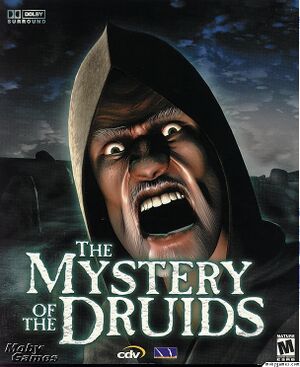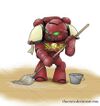Druid
>


Pre-christian Celtic priests often associated with nature and divination. And human sacrifice. Don't forget the human sacrifice. In modern times druidism has been revived under the new-age movements minus human sacrifice. In fantasy druids are often powerful magicians or cleric variants who get their powers from communing with nature, more like historical shamans.
They are a mysterious bunch. No one knows who they are, or what they are doing.
Druids in D&D
Druids have long been a staple class of D&D where they are known for their shapeshifting abilities, being able to turn into various animal forms, and being hilariously broken in 3.5e. Using this ability might incur the Familiarity Question, so make sure to run this by the DM prior to playing a Druid.
Druids are usually fairly close to being "good guys" since, even if their official thing is all about "preserve nature", the fact that bad guys in D&D tend to messing around with necromancy or summoning fiends tends to make for at least "enemy of my enemy is my friend" alliances. Evil druids are, honestly, something of a minority -- but they do happen. Forgotten Realms has the Shadow Circle, which are militant anti-city druids who want to violently destroy all forms of civilization. Eberron has two; the Circle of the Ashbound believe (falsely) that arcane magic harms nature and that destroying magical items and users is good for nature - long story short, it involves their founder killing a lich who'd been screwing around with nature and then noticing nature bounced back really well afterward - and the Children of Winter, social darwinists who believe that "Winter is coming!" and launch eco-terrorist attacks on civilization to winnow out the weak and ensure only the strong will be left to keep everybody from dying out during the "winter phase" of Eberron's life-cycle.
Druids in BECMI
The Druid first appeared in the Companion Set for Dungeons & Dragons BECMI; here, it was a kind of prototype prestige class, rather than a class in its own right. When a Neutral aligned Cleric reached 9th level, they could make a decision to either continue as a cleric or to devote themselves to the powers of nature, becoming a druid. This presented them with a bunch of new character restrictions, mandating that they live in the wilderness and forbidding them from using metal weapons or armor. In return, they could advance from their starting level of 10 to level 36, and gained access to new spells castable only by druids, in addition to casting all of the spells they had learned as common clerics.
Druids in AD&D
Druids in 3e & PF
Druids can turn into bears whose stats have been buffed into the stratosphere who can summon bears whose own stats have been buffed into the stratosphere out of their eyes while farting lightning, pissing acid, shitting explosive berries, and breathing fire that does irresistible damage, thus making your fighter look lame. A little harder to break in Pathfinder, but still top-tier.
Druids in 4e
4th edition seriously worked to fix the CoDZilla problem. Because of this, druids didn't appear until the second Player's Handbook. Here, they became a Primal Controller class, with the nebulous "old faith" and vague "cleric but not" status of earlier editions replaced with a coherent faith and a new set of pseudo-deities to worship; the Primal Spirits.
These druids don't have the animal companion of editions past, and summoning as an option was changed up, with no powers along that lines until the subsequent Primal Power, which provided them with their own distinctive array of summons and conjurations. The biggest change is to their shapechanging; whilst Wild Shape remains their key feature, being an at-will power that lets them turn into any animal, the original use of it is gone - wild shape is mostly cosmetic. Instead, druid powers are split halfway between mystical effects like calling lightning bolts, teleporting and making trees eat your enemies, and special attacks for the druid's beastform. This allows you to build your druid with a focus on either nature magic, being a shapeshifted killing machine, or a blend between the two.
The druid has a pseudo-subclass mechanic in the form of Primal Aspect, similar to those of any other class. Depending on which Aspect your druid chose, you get a certain bonus when not wearing heavy armor and certain affiliated powers are more potent. The PHB has the Primal Guardian (use Con to determine AC) and Primal Predator (+1 speed) Aspects, whilst Primal Power has the Primal Swarm Aspect (damage reduction when in beast form).
The Essentials books also gave the Druid two variant classes that focused on different aspects of the Druid as a class. The "Protector" from Heroes of the Feywild was a more Wizard-like Druid, gaining cantrips in the form of Primal Attunement in exchange for losing Ritual Caster and exchanging Wildshape for "Primal Growth", an Encounter power that acted as difficult terrain and had other benefits based on the Druid Circle selected: Renewal (The Predator-equivalent) gave anyone who spent a Healing Surge near it extra HP while Shelter (The Protector Equivalent) made it not count as difficult terrain for allies. The other key aspect of this class was making all Dailies become Summon Nature's Ally powers, summoning different creatures depending on both level and Circle. Heroes of the Forgotten Lands gave the "Sentinel", a more martial pet-centric Druid who followed the later Essentials classes of being almost mono-builds. The only major choice you get is the Acolyte of the Seasons feature, which determines a few bonuses as well as which pet you get: Spring (Wolf), Summer (Bear), and Wastes (Living Zephyr). You get an Encounter power called Combined Attack which lets you hit and then let your pet hit as well as taking the Cleric's Healing Word.
Druids in 5e
However, in D&D 5th edition, buff spells have been changed and the Druid no longer gets an animal companion; however, this is quickly brushed aside when players realize that they can wildshape into a bear at 2nd level (as a bonus action) thanks to the Circle of the Moon. Druids get two choices in 5e: Circle of the Lands, where they pick a chosen land (the Underdark is on the list) and get spells relating to it. Circle of the Moon gives them tons and tons of shapeshifting bonuses, as well as the ability to heal themselves while in wildshape by burning spells. They also have Druidcraft, a spammable cantrip that can work like a weather app, tiny amounts of fertilizer, a candle, or matches depending on how you need to prove your druidic might to someone today.
In November 2016, Unearthed Arcana gave them their first bunch of new Circles; the fae-empowered Circle of Dreams, the conjuration-master/pseudo-Shaman Circle of the Shepherd, and the undead-fighting Circle of Twilight. In addition, the imaginatively named Three Subclasses Unearthed Arcana added the Circle of Spores, which is basically a Nurgle druid.
| Dungeons & Dragons 4th Edition Classes | ||
|---|---|---|
| Player's Handbook 1 | Cleric • Fighter • Paladin • Ranger • Rogue • Warlock • Warlord • Wizard | |
| Player's Handbook 2 | Avenger • Barbarian • Bard • Druid • Invoker • Shaman • Sorcerer • Warden | |
| Player's Handbook 3 | Ardent • Battlemind • Monk • Psion • Runepriest • Seeker | |
| Heroes of X | Blackguard* • Binder* • Cavalier* • Elementalist* • Hexblade* • Hunter* • Mage* • Knight* • Protector* • Scout* • Sentinel* • Skald* • Slayer* • Sha'ir* • Thief* • Vampire* • Warpriest* • Witch* | |
| Settings Book | Artificer • Bladesinger* • Swordmage | |
| Dragon Magazine | Assassin | |
| Others | Paragon Path • Epic Destiny | |
| *·: Non-AEDU variant classes | ||
| Dungeons & Dragons 5th Edition Classes | |
|---|---|
| Player's Handbook | Barbarian • Bard • Cleric • Druid • Fighter • Monk Paladin • Ranger • Rogue • Sorcerer • Warlock • Wizard |
| Tasha's Cauldron of Everything | Artificer • Expert • Spellcaster • Warrior |
| Van Richten's Guide to Ravenloft | Apprentice • Disciple • Sneak • Squire |
| Unearthed Arcana | Mystic |
| The Classes of Pathfinder 1st Edition | |
|---|---|
| Core Classes: | Barbarian - Bard - Cleric - Druid - Fighter - Monk Paladin - Ranger - Rogue - Sorcerer - Wizard |
| Advanced Player's Guide: |
Alchemist - Antipaladin - Cavalier Inquisitor - Oracle - Summoner - Witch |
| Advanced Class Guide: |
Arcanist - Bloodrager - Brawler - Hunter - Investigator Shaman - Skald - Slayer - Swashbuckler - Warpriest |
| Occult Adventures: |
Kineticist - Medium - Mesmerist Occultist - Psychic - Spiritualist |
| Ultimate X: | Gunslinger - Magus - Ninja - Samurai - Shifter - Vigilante |
